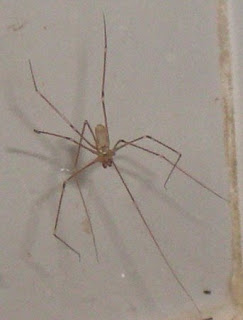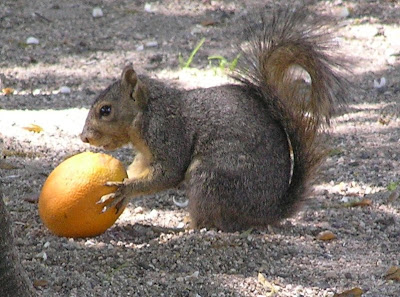
Showing posts with label wildlife. Show all posts
Showing posts with label wildlife. Show all posts
Spiders!
I found this one in the shower this morning. It appears to be an example of the woodlouse spider (Dysdera crocata). They specialize in eating the woodlouse (known locally as pillbug or sowbug). They will bite, but their bites, while possibly a bit painful, are not dangerous. They are sometimes mistaken for the poisonous brown recluse spider, but they don't really look alike.


Great Horned Owl

But in ten years in West Hills, we've had neither sight nor sound of an owl, until last night. I woke up around 3:30 am to repeated calls. If there were any replies, I couldn't hear them.
This area provides a good living for birds of prey. There are rabbits, rats, mice, lizards, and small birds of all kinds. We see hawks every day, and on a few occasions, kestrels. I'm sure there have been owls here all along, but they have managed to remain unknown until now.
At WhatBird, you can search for "great horned owl" and find out exactly how they sound.
Rats!

We may not see them, but they are there. The Norway Rat (Rattus norvegicus), also known as the sewer rat, brown rat, etc., thrives in and around human habitats. This one was seen foraging among the fallen birdseed under one of our feeders. It looked fat and healthy. But beware: Rats and squirrels are among the many animals linked to plague, rabies and other nasty diseases here in South California.
Coyotes!

Side-Blotched Lizard
 The common side-blotched lizard (Uta stansburiana) is one of the most abundant lizards in South California. They are able to survive in a variety of habitats, and prefer open, rocky areas. As with many other lizards in this region, their tails may break off if they are caught, and will grow back to some extent. Their life span is only about a year, and they produce eggs in the spring and summer. Active during the day, they eat small invertebrates. They should be very happy in this area, where we have a huge supply of crickets and grasshoppers.
The common side-blotched lizard (Uta stansburiana) is one of the most abundant lizards in South California. They are able to survive in a variety of habitats, and prefer open, rocky areas. As with many other lizards in this region, their tails may break off if they are caught, and will grow back to some extent. Their life span is only about a year, and they produce eggs in the spring and summer. Active during the day, they eat small invertebrates. They should be very happy in this area, where we have a huge supply of crickets and grasshoppers.
Hummingbird Nest
 I found this hummingbird nest on the patio. Old nests often tumble from trees or blow in on the wind. I have a feeling this one was never used; typically the used nests are more compacted, especially on the inside. Made of local plant materials, this was a little over two inches in diameter.
I found this hummingbird nest on the patio. Old nests often tumble from trees or blow in on the wind. I have a feeling this one was never used; typically the used nests are more compacted, especially on the inside. Made of local plant materials, this was a little over two inches in diameter.Hummingbirds are federally protected under the Migratory Bird Treaty Act. We should never harm, disturb or collect the birds or any of their parts, including feathers, eggs and nests. If you find a nest which appears to be in trouble, such as one containing eggs or babies which has fallen to the ground, you should immediately contact a licensed wild bird rehabilitator.
This empty nest will be allowed to continue drifting naturally on the wind.

Arachnophobia?
 I photographed these daddy long-legs spiders (Pholcus phalangioides) in the women's restroom of the horticulture building at Pierce College. They seemed cozy, moving around their web in the narrow space between the side of the toilet and the wall. I photographed these daddy long-legs spiders (Pholcus phalangioides) in the women's restroom of the horticulture building at Pierce College. They seemed cozy, moving around their web in the narrow space between the side of the toilet and the wall.It's a good thing I'm not afraid of spiders, but this might explain why this restroom, unlike all the others on campus, seemed so clean. (Well, except for the part with the spiders.) No one dares use it. Apparently the Plant Facilities department has not yet issued brooms to this remote outpost. |
 Usually found in or around houses, the daddy long-legs is sometimes also called the cellar spider. (It is occasionally confused with a couple of other species that are also sometimes called long-legs or daddy long-legs.) They like to hang upside down from their webs and wait for prey. They eat small insects and spiders. When food is short, they will eat their own kind.
Usually found in or around houses, the daddy long-legs is sometimes also called the cellar spider. (It is occasionally confused with a couple of other species that are also sometimes called long-legs or daddy long-legs.) They like to hang upside down from their webs and wait for prey. They eat small insects and spiders. When food is short, they will eat their own kind.
Alligator Lizard

We see a lot of lizards in this area. This is a southern alligator lizard (Elgaria multicarinata), a little over a foot long, relaxing in my driveway. Some individuals will grow to twice this length. These reptiles eat insects and snails, occasionally smaller lizards or bird eggs. If grabbed by a predator, the tail will break off easily, enabling the lizard to escape. (However, I have seen cats temporarily distracted by the tail who then went on to capture and eat the lizard.) The tail will regenerate to some extent, but the new tail will never have the length or beauty of its predecessor. This lucky little guy still has his original tail.

Not Exactly a Day at the Beach
 We expect to see seagulls at Lake Balboa, but this raucous flock was gathered around a rather pathetic puddle in a parking lot at Victory and Owensmouth. The real attraction seemed to be an uncovered dumpster filled with garbage from a couple of nearby restaurants.
We expect to see seagulls at Lake Balboa, but this raucous flock was gathered around a rather pathetic puddle in a parking lot at Victory and Owensmouth. The real attraction seemed to be an uncovered dumpster filled with garbage from a couple of nearby restaurants.
Grasshopper
 It's not unusual to find grasshoppers drowned in the pool, but this one saved itself by perching on a hose. The gray bird grasshopper (Schistocerca nitens) is native to the American southwest. We see a lot of them here this time of year. They appear in shades of gray or brown, and can be as much as three inches long. (This one was definitely that big.) They eat plants, but unlike some other species (including locusts) they do not form huge, destructive swarms. They fly rather awkwardly, sometimes crashing into people when they should be escaping.
It's not unusual to find grasshoppers drowned in the pool, but this one saved itself by perching on a hose. The gray bird grasshopper (Schistocerca nitens) is native to the American southwest. We see a lot of them here this time of year. They appear in shades of gray or brown, and can be as much as three inches long. (This one was definitely that big.) They eat plants, but unlike some other species (including locusts) they do not form huge, destructive swarms. They fly rather awkwardly, sometimes crashing into people when they should be escaping.
Squirrels

This little guy is a member of the species sciurus niger, commonly known as the fox squirrel. These active rodents are seen all over the valley in back yards and parks, running along telephone wires, scampering across roofs, getting run over in the streets, and picking fruit from the trees just as it is about to ripen. Maddeningly, they usually eat just a few bites and discard the rest.
 The fox squirrel is not native to California. Around 1904, military veterans from the Mississippi Valley area, who were staying at the Sawtelle Veterans Home on Wilshire Boulevard in Los Angeles, brought the animals here from their homes. By the 1940s the fox squirrel had come to be considered an agricultural pest. During the past century, it has expanded its range, and is now found throughout the Santa Monica Mountains, San Fernando Valley and Simi Valley. The animals are seen as far south as the Palos Verdes Peninsula, and to the east throughout Orange County. After so many generations, they probably consider themselves natives, but many naturalists are concerned that they may be displacing our true native species, the western gray squirrel (sciurus griseus).
The fox squirrel is not native to California. Around 1904, military veterans from the Mississippi Valley area, who were staying at the Sawtelle Veterans Home on Wilshire Boulevard in Los Angeles, brought the animals here from their homes. By the 1940s the fox squirrel had come to be considered an agricultural pest. During the past century, it has expanded its range, and is now found throughout the Santa Monica Mountains, San Fernando Valley and Simi Valley. The animals are seen as far south as the Palos Verdes Peninsula, and to the east throughout Orange County. After so many generations, they probably consider themselves natives, but many naturalists are concerned that they may be displacing our true native species, the western gray squirrel (sciurus griseus).
Red Tailed Hawk
 Red-tailed hawks are found in the valley year-round. They are often seen soaring above open fields or brushy areas. They hunt small mammals, birds and reptiles. This one was perched in a favorite spot, a pine tree that overlooks my back yard.
Red-tailed hawks are found in the valley year-round. They are often seen soaring above open fields or brushy areas. They hunt small mammals, birds and reptiles. This one was perched in a favorite spot, a pine tree that overlooks my back yard.
Subscribe to:
Comments (Atom)


 These seagulls at Lake Balboa seem to be standing in formation.
These seagulls at Lake Balboa seem to be standing in formation.